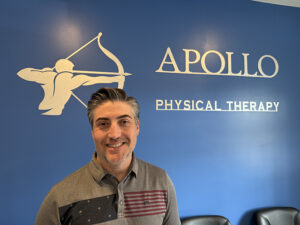Use It or Lose It: How to Start Exercising
Start slow and gradually start challenging yourself, say experts
By Deborah Jeanne Sergeant

You know the phrase: use it or lose it. You know you need to exercise regularly for your health and wellbeing. But how to get started is often left out of the conversation.
Physician David A. Quinzi, an orthopedist with Syracuse Orthopedic Specialists in Syracuse, recommends keeping it simple.
“The activity to add can be as simple as walking daily in your neighborhood or more aggressive like going to the gym and signing up with a trainer or local classes,” he said.
Walking costs nothing and adds a low-impact, weight-bearing workout to your day. Performing weight-bearing exercise helps protect your bones.
Walking requires no special equipment, just a good pair of comfortable shoes. Bringing along a walking buddy — whether human or canine — can help keep you motivated. Many communities have a fitness center at the high school available for little to no money. But to get more motivation to go to the gym, sign up for personal training or a class at a commercial gym. Accountability will draw you back. (“Where were you last night?”)
“It can be difficult to start these activities but once you get into a dedicated routine the body begins to acclimate and even crave movement,” Quinzi said.
If getting to a gym isn’t possible, try virtual training. Quinzi recommends looking for videos on YouTube or checking out fitness apps.
“With anything, start slow and listen to your body,” he said. “It seems simple but if it feels wrong or painful it probably is.”
It’s not that at this age you can’t do activity that’s strenuous. But you need to work up to that point if you have not been exercising all along or you’ll likely get injured, laid up and moving even less. YouTubers who are 65 and working out like maniacs at the gym have been working out all their lives.
Michael Cioci, physical therapist at Apollo Physical Therapy in Oswego, advises to “start simple if you haven’t worked out since you were 25. You may not get away with pounding on your joints.”
In addition to walking, low-impact activity could include biking, yoga and light weights. Over time, increase the difficulty, like hiking in an area with a few hills, adding weight to a pack during a hike or lifting slightly heavier weights.
“If you can’t get into running and want to get your heart rate up, throwing 10 to 20 pounds on your back will increase the difficulty with fairly low impact,” Cioci said. “Everything’s gradual. You don’t need to throw 100 pounds on your back.”
In addition to working out, you need to plan rest. That doesn’t mean remaining completely inactive the next day but alternating the type of movement or the area of the body that’s worked.
“Recovery as we age is more important,” Cioci said. “Lift weights one day, bike or walk the next day.”
This allows the body time to strengthen muscles and recuperate. Staying completely inactive can lead to greater stiffness.
Above all, don’t expect to look like Arnold Schwarzenegger in a month or two (or ever). Building muscle and stamina and losing flab takes time and a moderate calorie, healthful diet. Instead, focus on how you feel and function.
Pushing yourself too hard, especially right away, can cause serious injuries.
“When you get into weights, you will get much stronger quickly but it takes time for the tendons to catch up,” Cioci said. “Not every part of you is getting stronger at the same rate. As we age, blood flow doesn’t get to certain structures as well as it used to. You’re more prone to tendonitis if you ramp up too fast. Give it a week or two at a lower level after you have ramped it up.”

